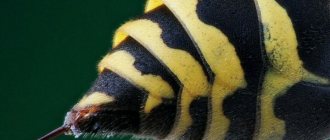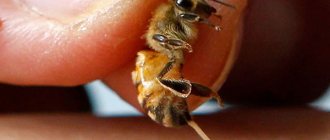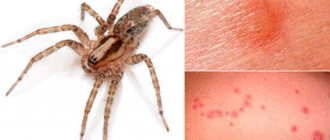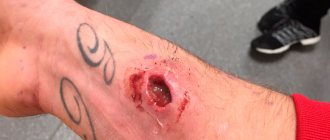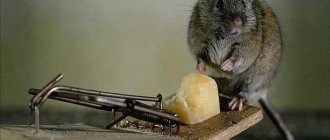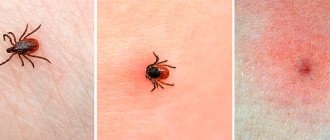Symptoms of bites
If a bee stings, the animal’s reaction is the same as a person’s. When poison enters the bloodstream, swelling, swelling, redness, pain, burning, and eventually itching appear at the site of the bite. In some cases, symptoms disappear on their own within a few days, without special treatment. In another situation, an urgent visit to a specialist is required. The photo is presented below.
If a cat is bitten by a bee, a severe allergic reaction may occur, which is manifested by a general deterioration in the animal’s well-being.
- vomit;
- lack of appetite;
- convulsions;
- lacrimation;
- increased salivation;
- trembling throughout the body;
- temperature increase;
- loss of consciousness;
- hard breath;
- swelling of the larynx.
The allergy appears within the first 20 minutes after a bee stings. But complications may occur the next day. If after first aid the cat’s condition does not improve, you should take the pet to the veterinarian or consult by phone.
Bee sting on cats
What to do if a cat is bitten by a bee or wasp
Cats are playful, active hunters who often choose insects as prey. In defending themselves, buzzing hymenoptera cause serious damage with their venom. When your pet is bitten by a wasp, he needs to be helped and monitor his further actions.
Depending on the affected area and the distinctive characteristics of the animal’s body, a bite can have different effects on well-being and often lead to death. If your pet's condition worsens, you should immediately go to the veterinarian.
What to do if a cat is bitten by a wasp? If your cat is suddenly stung by a bee or wasp, it is important to know the symptoms of an allergic reaction and steps to help at home.
Symptoms
The owner does not always have the opportunity to keep track of his pet, but based on his behavior he should suspect the fact of a wasp sting. The cat often meows pitifully, scratches, and licks the stung area. A more detailed examination of the lesion usually reveals a red spot, swelling, marks from claws, teeth, with which the animal wants to quench the itching that has arisen.
The degree of inflammation depends on the weight, age and type of insect that bit your pet. The most extensive swelling will appear in a kitten stung by a bee on the nose, cheeks or eyes. A wasp bite on the tongue is especially dangerous. The symptoms here are similar to those in humans:
- round redness;
- edema;
- burning, itching;
- pain.
An animal stung by an aggressive bee rushes around the corners, its behavior is restless, sometimes violent. When wasp venom gets into your cat's paw, lameness occurs. These signs are caused by a developing allergy to wasp toxin, which is accompanied by the above consequences, as well as:
- diarrhea;
- lacrimation;
- convulsions;
- swelling of the larynx;
- increased temperature;
- lack of appetite, weakness.
In mild cases of a wasp or bee sting, all signs disappear on their own after a few days. But in view of the existing danger of damage to your pet’s respiratory tract and the onset of suffocation, veterinarians recommend taking immediate action immediately after detecting a problem.
Finding the bite site
Locating a sting point can be challenging. The cat becomes active, aggressive, hisses, scratches, bites.
You should monitor your pet's behavior. If the lesion is on the muzzle - swelling is noticeable, in the paw - lameness, the cat will constantly lick or tear other points on the body with its claws.
The insect bite is often visible and clearly marked by redness. When initial symptoms occur, immediate treatment is required to reduce the allergic reaction in the cat.
If a wasp, bee or bumblebee sting occurred on the nose, but your cat was not given timely help, the resulting swelling will prevent the animal from eating normally. With significant complications, the latter can spread to the respiratory tract and lead to suffocation.
When a bee stings your cat in the cheek area, swelling of the latter is observed, with the swelling possibly spreading to other parts of the body.
If affected, the pet shows weakness, develops chills, increased heart rate, wheezing and difficulty breathing. A cat’s body’s strong reaction to a wasp sting manifests itself in failures of its coordination.
This fact is easy to detect - the animal’s muzzle swells greatly, the lip protrudes, and the features become disproportionate. The cat leans against the cold wall, the ground, trying to calm the pain and get rid of the sting.
If a wasp has bitten your cat directly on the lip, then applying lotions is useless, just like using ointments. They will be licked off along with saliva and end up inside the stomach. Compresses must be used. To do this, use ice wrapped in a thin cloth. Compresses will help constrict the blood vessels, thereby preventing further spread of insect venom. The pain effect and swelling gradually decreases.
You can find out that your cat has been bitten by a poisonous bee on the throat or tongue not only by noticeable shortness of breath - severe swelling, vomiting, and excessive salivation occurs. This is one of the most dangerous types of toxin damage, accompanied by swelling of the nasopharynx.
You cannot hesitate for a second; it is better to immediately help your pet by providing intensive therapy with special medications available at home.
First aid
It is important to know what to do and how to act promptly, what medications to use if your cat is suddenly bitten by a bee.
The first step is to remove the sting, which could remain under the skin and continues to exude pathogenic poison. When a wasp stings, it is gone.
- The cat or cat needs to be taken from the street, provided with coolness and complete peace.
- The bee's sting must be removed carefully using tweezers so as not to damage its integrity. You need to act carefully, otherwise the end of the poisoned needle will remain under the pet's skin and further surgical intervention may be necessary. After removing the bee tip, you need to press on both sides of the hole with your fingers - blood will come out of it, and along with it the remaining poison should come out.
- Next, the problem area of the cat’s body is treated with an antiseptic to remove inflammation. This can be a pharmaceutical cream, drug, ointment or folk remedies.
- To make the swollen part go away faster, use a cold compress.
Allergy
If a bee sticks its sting into the muzzle area, there is a high probability of swelling of the larynx, which makes breathing difficult. Your cat should be immediately given adrenaline and antihistamine therapy, i.e. Give an antiallergic drug: ointment, tablets, drops.
Pedigree pets and cats with weak immunity are more susceptible to the development of reactions. Don't worry if your kitten swallowed a wasp or it doesn't bite inside the stomach. Make sure that the insect does not manage to sting the oral cavity. A bee sting is excluded when no symptoms appear within 30 minutes.
Treatment
There are no special cat medications available for the treatment of insect bites, so people turn to traditional medications for help. The pet’s body’s reaction to the wasp toxin varies: from a small swelling to an anaphylactic shock state.
If there are signs of the latter, immediate hospitalization of the cat is required. A weak inflammatory focus can be stopped with improvised drugs from the first aid kit or at home.
Pills
Often, animal owners, when symptoms of damage appear, use homeopathic Apis tablets, in a dosage of two or three pieces. They quickly remove the risk of developing a further allergic reaction. If your pet has previously suffered from severe forms of allergies, you should always have this medication at home.
It is advisable to use corticosteroids. This series of drugs is prescribed by a doctor and refers to hormonal anti-inflammatory medications. Experienced cat breeders use Prednisolone in the form of pills, at a rate of 0.5 - 1 mg of the drug per kilogram of animal weight.
To treat minor inflammation of soft tissues in cats, products based on medicinal herbs are used in the form of creams. They use the time-tested Zvezdochka, Bepanten, Menovazin. For symptoms of moderate severity, therapy with Fenistil gel is carried out. When the initial period of development of the disease has been missed, the clinical picture has acquired pronounced features, then the cat needs antiallergic ointments of deeper penetration: Triaccutane, Elokom, Advantan and Betamethasone.
In case of aggravating factors, in the form of a developed infectious focus, your cat requires a local antibiotic; the drugs most often used are Tetracycline, Gentamicin, Levomekol or Erythromycin.
Skin inflamed by a bee sting should be treated 1 to 4 times a day. As the disease disappears, the dosage is reduced. Treatments last 5-6 days. When the bite is on the body, paw or tail, and the cat’s well-being has not worsened, such therapy will be sufficient.
First aid
What to do if a cat is bitten by a bee, there is a certain mechanism of action. The insect leaves a sting in the pet's body, which continues to secrete, it needs to be removed. If, upon careful examination of the affected area, no bee sting is found, it means that the cat was bitten by a wasp.
- The sting should be removed carefully using tweezers. Using nails can damage the structure and leave part of an organ in the body, which is highly undesirable. Surgery will be required to remove it.
- Next, you should treat the sore spot with any antiseptic to neutralize the effect of the poison. For these purposes, medications and folk remedies are used.
- After disinfection, you need to relieve swelling and reduce pain. In this case, use a cold compress or ice cubes wrapped in a towel. The swelling will finally go away in a few days. It is recommended to repeat the procedure several times a day.
Important!
If there are signs of a severe allergic reaction, before being examined by a specialist, it is allowed to give the cat an antihistamine or activated charcoal to remove toxins.
First aid for a bee sting
First aid for a cat after a bee or other insect bite
A veterinary clinic and a veterinarian are not always ten minutes away. What to do when a cat is stung by a bee, what first aid can you provide yourself? First aid for a cat will depend on what type of insect is causing the discomfort for the animal.
- The cat was bitten by a wasp. The wasp does not leave a sting.
- The cat was bitten by a bee. In this case, you need to remove the sting from the cat’s body as soon as possible.
Further actions: make a compress with soda, reduce the itching from the bite site. A compress of baking soda solution will also reduce swelling. The compress should be cold or even ice-cold. Using such a compress, you will relieve pain in your pet. Remember the popular proverb: “Even a cat enjoys a kind word”; don’t forget to talk to the animal.
Separately, I would like to mention the drug Benadryl. Cat owners who are aware of an allergic reaction in their cats should always have this drug on hand. With the help of Benadryl, more than one cat has been pulled out of the dead after being stung by a bee or wasp.
Disinfestation products
You can treat the wound if a bee has stung a cat with medical alcohol, ammonia, any alcohol tincture, or hydrogen peroxide.
- Tincture of valerian, motherwort, and calendula soothes pain and relieves swelling. A small amount is applied to a cotton swab and applied to the sore spot.
- If there is no alcohol, prepare a paste from soda. Mix kitchen salt and baking soda in equal proportions, dilute with a little water to form a paste. Apply to the skin. Baking soda helps relieve swelling, pain, burning, itching.
- You can disinfect the wound with juice from orange, lemon, onion, and potato. Another effective remedy is laundry soap or an acidic solution. Table vinegar and citric acid are added to the water. They make lotions, apply a compress, wipe the skin.
In the future, to eliminate swelling, decoctions of medicinal herbs are used - chamomile, mint, lemon balm, calendula. The potion is poured with boiling water and left for half an hour. Sore spots need to be treated several times a day. The swelling goes away completely within 3 days.
Interesting!
The cat actively licks the bitten area with its tongue. Not only because the animal is in pain or unpleasant, but to disinfect the wound. Saliva is a natural antiseptic. Wild, stray cats treat themselves. The sting falls out over time without outside help.
Antihistamines
Antihistamines
After a bee sting on a cat's nose or other place on the face, an antihistamine should be given to avoid severe allergies. There is no special cat drug. Experts advise:
- Prednisolone. At home, give 0.5 tablets. Turn it into powder, dilute it with water, and pour it into the cat’s mouth. If immediate relief of an allergic reaction is required, an injection is given intramuscularly and 0.5 ml of solution is injected.
- Dexamethasone. More suitable for obvious signs of allergies - vomiting, nausea, difficulty breathing. An injection is given with a solution of 0.2 ml.
- Diazolin. It is recommended if a bee has bitten a kitten, an adult cat, or a cat. Dose – 0.5 tablets at a time. On the first day, an antihistamine is given three times.
- L-cet. A modern antihistamine is produced in the form of a suspension or tablets. In the first case, give 0.5 teaspoon per day, in the second - ¼ of the tablet.
To save a cat’s life after a bee sting, you can give any antihistamine that is in your home medicine cabinet, but then you should show your pet to a specialist. Carry out further therapy under the supervision of a veterinarian.
Important!
If a bee bites a cat on the paw, there is no particular cause for concern. But an animal may have an individual intolerance to bee venom. In this case, the consequences are unpredictable, the paw noticeably swells. To avoid complications, you need to give an antihistamine immediately after discovering a bite.
Cat treatment
The bite goes away completely within a week. Pain and swelling are gradually replaced by itching. There is a risk of secondary infection if the pet begins to scratch the itchy wounds. To avoid suppuration and the development of ulcers, wounds after a bite should be treated daily to reduce itching.
It is allowed to use topical creams and ointments: Zvezdochka balm, Fenistil Gel, Beinval. Or use folk remedies:
- juice of fresh parsley leaves;
- leaf of plantain, yarrow;
- dandelion roots;
- lemon slice;
- a piece of raw potato;
- tansy decoction;
- aloe juice;
- chopped onion, garlic;
- salty water.
Medicines are applied to the skin, lotions and compresses are made. If the situation does not improve within 3 days, you should seek help from a specialist. In most cases, to alleviate the suffering of a pet, it is enough to provide first aid and monitor the cat’s well-being for several days.
Signs of anaphylactic shock
- weakness, unnatural behavior: the animal is lethargic or overly excited;
- vomit;
- mucous membranes are pale or bluish;
- breathing is difficult, wheezing is heard;
- the pulse quickens and becomes weak;
- cramps, involuntary urination.
Anaphylactic shock occurs in one animal in a thousand, but it can cause death. If a cat shows signs of anaphylactic shock after an insect bite, it is necessary to take the animal to the veterinarian as soon as possible. A cat can die within an hour if you don't give it help.
